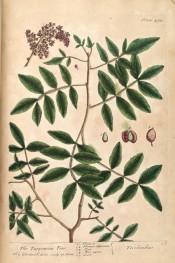Pistacia terebinthus L.
Small tree or large shrub with dark, glossy, aromatic, pinnate leaves and green unisexual flowers followed by small reddish-purple fruits. To 9m or more. [RHSD, Hortus, Hilliers’].
Horticultural & Botanical History
‘The Turpentine-Tree. Terebinthus. This grows to a large tree in the Eastern Countries; the leaves are a bright grass green, and the flowers purple. It grows in the Island of Chio [Chios, Greece], from whence we have the best Turpentine, and flowers in April. The Liquid Rosin of this tree was preferred by the Ancients to all other kinds; now called Turpentines, for affections of the breast & lungs, and for diseases of ye kidneys or blader; as stone, gravel and stoppage of urine. It is frequently used for the Fluor Albus and Gonorrhaea.’ [Blackwood pl.478/1739].
‘Flückiger and Hanbury remark:- “The several forms of this tree are regarded mostly as so many distinct species; but after due consideration and the examination of a large number of specimens both dried and living, we have arrived at the conclusion that they may fairly be united under a single specific name.” (Pharmacographia). Aitchison after a careful examination comes to the same conclusion.
The terebinth tree was well known to the ancients; it is the [greek, untranslated] of Theophrastus, [greek, untranslated] of other authors, and the Alah of the old Testament. Among its products, the kernels were regarded by Dioscorides as unwholesome, though agreeable in taste. By pressing them, the original Oil of Turpentine, [greek, untranslated], a mixture of essential and fat oil was obtained, as it is in the East to the present day. The resinous juice of the stem and branches, the true, primitive turpentine, [greek, untranslated], was celebrated as the finest of all analagous products, and preferred both to mastich and the pinic resins. (Pharmacographia.) The tree was held in veneration by the Jews; Abraham raised an altar to Jehovah near a grove of Pistacia trees in the valley of Hebron; their dead were buried near the tree. Pliny (13, 12,) notices the fruit of the Terebinthus as well as the galls, “from which issue certain insects like gnats,” also a kind of resinous liquid which oozes from the bark. Again (24, 18,) he says:- “The leaves and root of the Terebinthus are used as applications for gatherings, and a decoction of them is strengthening to the stomach. The seed is taken in wine for headache and strangury: it is slightly laxative and acts as an aphrodisiac.” Aitchison tells us that P. Terebinthus occurs in groups on the low hills of Persia and Afghanistan, the kernels are roasted and eaten, and their oil expressed and used with food. The leaves are used in tanning and dyeing, and on their margins are formed small galls quite distinct from those of P. vera. These small galls we have observed in the Bombay market for the first time this year offered for sale as Pistachio galls. The turpentine of P. Terebinthus is the Butm of the Arabs, and it seems probable that the particular kind produced in Afghanistan, and known in India as Mastaki, is the Ilak-el-Ambat or “turpentine of the Nabatheans” of Ishak bin Imran. It is used as substitute for true mastich or Ilak-el-Rumi, and sometimes appears in the European markets as East Indian or Bombay mastich.’ [Dymock – Pharmacographia Indica part. 1, p.377/1889].
Introduced to Britain by 1656. [JD].
History at Camden Park
Pistacia terebinthus is marked with a ‘c’ in an 1836 edition of Loddiges’ catalogue held at Camden Park [CPA]. In William Macarthur’s code, used and explained elsewhere, this means grown at Camden. It is almost certain that it was grown in the gardens around this time but it did not appear in the catalogues and may have been short-lived. The plant yields a resin, Chian turpentine, once used in medicine and this may have been Macarthur’s interest in it as it is of little ornamental value.
Notes
Pistacia terebinthus Mill. (1768) = Pistacia vera L.
Pistacia terebinthus M.Bieb. (1808) = Pistacia mutica Raul ex Boiss.
Published Apr 02, 2010 - 04:26 PM | Last updated Apr 02, 2010 - 04:40 PM
| Family | Anacardiaceae |
|---|---|
| Category | |
| Region of origin | Mediterranean to Asia |
| Synonyms |
|
| Common Name | Chian turpentine tree, Cyprus turpentine tree |
| Name in the Camden Park Record |
Pistacia terebinthus |
| Confidence level | high |


